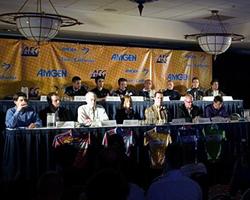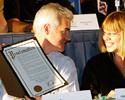News feature, February 28, 2007
Drug testing status clarified at 2007 Tour Of California
By Kirsten Robbins, with additional reporting from Tim Maloney

|
During the press conference after stage six of the 2007 Tour of California, Shawn Hunter, president of event owner AEG Sports, confirmed that testing for EPO had been being carried out this year at the request of the race's title sponsor, the biotechnology firm Amgen.
The company, which is one of the world's largest manufacturers of EPO, had requested that testing take place in the 2006 event, but this request was seemingly overlooked.
UCI president Pat McQuaid also stated in the same press conference, "As it is, AEG and the organizers at the Amgen Tour of California have gone further than the norm that would be required in terms of the testing that has happened at the race this year," McQuaid said.
"The UCI does blood tests at most but not all but most of the major ProTour events. Outside of the ProTour events we don't do as many blood tests. (The Tour of California) being in its second year would not warrant the blood test to be done.
"The effort it takes to bring the equipment here and the people to administer the test is very expensive. The people who administer the test are specialists and they are trained to read the machines that they bring so it is very expensive," he said. "At the moment (EPO blood testing) has only ever been done in Europe. I would certainly say that as the race progresses in the next year or two and becomes more important and prestigious, blood tests will be a factor that will be introduced."
The EPO (urine) testing for the 2007 Tour of California, is being conducted by the WADA-approved UCLA Olympic Analytical Laboratory in West Los Angeles, CA, headed by Dr. Don Catlin. But it's understood that this laboratory can also conduct the more sophisticated EPO blood test. The EPO blood test can detect the use of synthetic EPO for up to three weeks after use, whereas the urine test can only detect EPO use within a few days after being administered.
"The Tour of California being in its second year would not warrant the blood test to be done."-UCI president Pat McQuaid feels there's no need for blood testing at ToC, at least for now. |
The UCI's medical officer at the Tour of California, Shawn Farrell, said, "Yes the race is doing EPO tests at the Tour of California through urine samples and the tests are all being sent to UCLA (Olympic Analytical Laboratory)".
Farrell continued, "In terms of blood testing, the system I am familiar with is that (the UCI) have a set of people they use from the labs in Switzerland that they send out to various races for blood testing. I don't know that it has anything to do with where they do the actual testing of the samples. It has more to do with the where the actual people are who draw the blood and process it. Up until now they are a very small group of people located in Europe they have sent them to the US on some occasions. It doesn't have anything to do with the lab because the stuff can be tested almost anywhere."
According to a July 2006 article by Dan Shaughnessy in the Boston Globe, the UCLA lab has the equipment and expertise available. "Erythropoietin, a blood-boosting element better known as EPO, gets its very own room (at the UCLA Lab)", he wrote. It's believed the UCLA lab has had EPO testing in place since the 2002 Winter Olympics in Salt Lake City, where cross-country skiers, biathletes, Nordic combined athletes and long-track speed skaters were tested for EPO.
Prior to the Salt Lake Games, Dr. Catlin and his team developed a new test for darbepoetin, a long-acting form of EPO that caught out cross-country-skiing gold medalists Johann Muehlegg, of Spain and Larissa Lazutina, of Russia, for use of the drug.
EPO becomes a generic

|
Synthetic recombinant EPO, developed and marketed as Epogen by the Tour of California sponsor in the late 1980s, became a popular dioping agent for endurance athletes from the early ‘90s. Its unethical use led to the development of a doping test in 1999 by researchers at the then Australian Sports Drug Testing Laboratory (ASDTL) and the Australian Institute of Sport (AIS), who also jointly conducted an EPO administration trial.
The results were used to produce a method or test to predict current or recent abuse of EPO using indirect markers. At the same time, another IOC-accredited laboratory in France was developing a test to distinguish between administered and natural EPO in the urine, called the Lasne test, developed by Dr. Françoise Lasne, head of the biology department at the National Anti-Doping Laboratory in Chatenay-Malabray France, to distinguish between natural erythropoietin (EPO) and the banned synthetic version.
The Lasne test revealed that that natural EPO was more acidic than the recombinant [genetically engineered] EPO. Through a process called isoelectric focusing, the French researchers were able to pinpoint synthetic EPO in the urine.
But Dr. Lasne told the Associated Press last year that her test was not a foolproof solution for detecting the difference between natural erythropoietin and recombinant, or genetically engineered EPO. There have been changes in doping strategies since the original test was implemented at the 2000 Olympics, such as using very small levels of EPO, known as micro-dosing.
"Micro-dosing reduces the time EPO remains in the system to about 48 hours," said Lasne. "The evolution of new EPO products is another reason to improve testing methods", Lasne explained.
"Originally, only two forms of synthetic EPO were available. But with the expiry of patents, generic products have appeared on the market. Also, new synthetic forms of EPO, more or less similar to the old ones, have also been produced. Chemical production methods have also emerged, so urine tests (for EPO) have to be broader than before. They have to test not only for natural or non-natural EPO, but have to go further than what is present."

